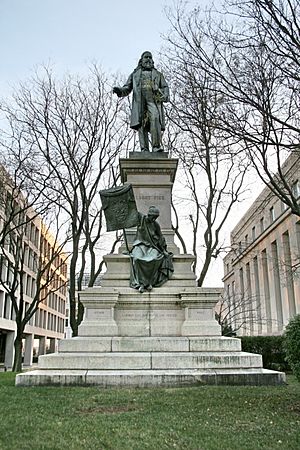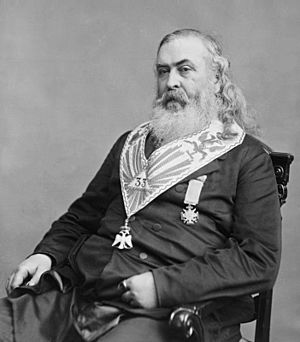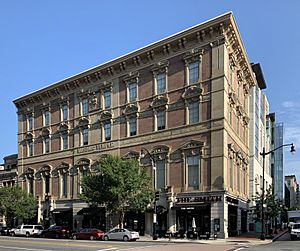Albert Pike Memorial facts for kids

Albert Pike Memorial in 2008
|
|
| Coordinates | 38°53′41″N 77°00′57″W / 38.8946°N 77.0157°W |
|---|---|
|
Albert Pike Memorial
|
|
|
U.S. Historic district
Contributing property |
|
| Part of | Civil War Monuments in Washington, D.C. |
| NRHP reference No. | 78000257 |
| Added to NRHP | September 20, 1978 |
| Location | 3rd and D Streets NW, Washington, D.C., United States |
| Designer | Gaetano Trentanove |
| Material | bronze (sculpture) granite (base) |
| Height | 28 feet (8.5 m) (sculpture and base) |
| Opening date | October 23, 1901 |
| Dedicated to | Albert Pike |
| Dismantled date | June 19, 2020 |
The Albert Pike Memorial is a public statue in Washington, D.C.. It was built to honor Albert Pike (1809–1891). He was a senior officer in the Confederate States Army during the American Civil War. Pike was also a poet, a lawyer, and an important leader in Freemasonry.
The memorial is located near 3rd and D Streets NW in the Judiciary Square area. Today, only the base and a sculpture of the Goddess of Masonry remain. The original bronze figures were made by Gaetano Trentanove, an Italian-American artist. The memorial was officially opened in 1901 with a large parade of Masons.
This memorial is one of 18 Civil War monuments in Washington, D.C. These monuments were all added to the National Register of Historic Places in 1978. The National Park Service takes care of the memorial. The statue of Pike was the only outdoor sculpture in Washington, D.C. that honored a Confederate general.
Even though Pike was shown as a Mason, not a soldier, the memorial caused arguments for many years. In June 2020, during protests related to the killing of George Floyd, the statue was pulled down and burned.
Contents
History of the Albert Pike Memorial
Who Was Albert Pike?

Albert Pike was born in Massachusetts in 1809. He worked as a schoolteacher and explored the American frontier before settling in Arkansas. There, he continued teaching and writing poetry, which he loved to do. He later became a successful lawyer. He helped Native American groups with their claims against the U.S. government.
Pike served as a captain in the Mexican–American War. After the war, he went back to being a lawyer. In the 1850s, Pike supported the idea of slavery. When Southern states left the United States in 1861, he sided with the Confederacy.
During the American Civil War, Pike became a brigadier general in the Confederate States Army. He used his knowledge of Native Americans to form an Indian cavalry that fought for the Confederacy. He led them in the Battle of Pea Ridge. After a few months, Pike left the army and returned to practicing law.
Pike's Role in Freemasonry
Around 1870, Pike moved to Washington, D.C.. He continued his law practice and his important role in Freemasonry. Pike had become a Mason in 1850 and quickly became a top leader. He was the Sovereign Grand Commander (SGC) of the Supreme Council, Southern Jurisdiction (SCJC) from 1859 until he died in 1891.
Pike wrote and explained Masonic rituals. He also put together an important book for the organization called Morals and Dogma of the Ancient and Accepted Scottish Rite of Freemasonry. This book was very influential among Masons.
Pike once said he wanted his monument to be in the "hearts and memories" of his fellow Masons. However, a few years after he died, Masons began planning a real monument in Washington, D.C.
Building the Memorial
The SCJC chose Italian-American artist Gaetano Trentanove to create the memorial. Trentanove knew Pike and was known for his sculptures. While Trentanove worked, Masons asked members of Congress for public land in Washington, D.C., for the monument.
When Union veterans, who were part of the Grand Army of the Republic, found out about plans for a Confederate general's memorial, they were upset. They told Congress it would dishonor Union soldiers. But Masons promised that the statue would show Pike as a civilian, not a soldier. On April 9, 1898, Congress approved the memorial.
Work on the memorial site began in 1899. On July 4, 1900, the cornerstone was laid. Before this, Masons gathered at the House of the Temple, where Pike had lived. They signed a paper with the date and their names. This paper was put in a bottle and placed in the memorial's foundation. The memorial cost $15,000, which Masons raised.
Dedication Ceremony
The dedication ceremony happened on October 23, 1901. This date was chosen to celebrate 100 years of the SCJC. At 2 P.M., Masons marched from the Masonic Temple to the memorial site. Thousands of Masons took part in the parade.
The parade ended at the memorial, which was on a triangular piece of land. A large stand was built for guests and participants. After music, Masonic leaders pulled a rope to uncover the memorial, which was covered by a U.S. flag. The crowd cheered, and a prayer was given.
Frederick Webber, a secretary for the SCJC, gave a speech. He officially gave the memorial to the American people. He said it was a "loving tribute" from Pike's fellow Masons. H. B. F. McFarland, President of the District Commission, accepted the memorial. He said that even though Pike was a soldier, the statue honored his "victories of peace." The ceremony ended with more music and a blessing. Pike was mostly shown as a kind poet during the event.
Later Years of the Memorial
For many years, groups like the United Daughters of the Confederacy held ceremonies at the site on Pike's birthday. Masons would also decorate the memorial. In 1972, the memorial was moved because of construction for Interstate 395. It was put back near its original spot in September 1977.
The memorial is part of the Civil War Monuments in Washington, D.C.. These were all listed on the National Register of Historic Places in 1978. The memorial is also part of the Pennsylvania Avenue National Historic Site. In 1993, experts said the memorial was "well maintained." The National Park Service owns and takes care of it.
Design and Location of the Memorial
The Pike memorial was the only outdoor sculpture in Washington, D.C., honoring a Confederate general. However, Pike was shown in civilian clothes, not a soldier's uniform. The memorial is located at the corner of 3rd and D Street NW. It is between the U.S. Department of Labor building and the police headquarters.
The bronze sculpture of Pike was about 11 feet (3.4 meters) tall. It showed him as a Masonic leader. He wore a long coat and held a book, likely his work Morals and Dogma. This sculpture sat on a granite base that was about 17.2 feet (5.2 meters) tall.
On the front of the memorial, there is a bronze sculpture of the Goddess of Masonry. She holds the banner of the Scottish Rite. She wears a long Greek robe and looks downward.
The memorial has several inscriptions:
- G. TRENTANOVE / FLLI GALLI FUSERO (on the base of Pike's sculpture)
- 33 / DEUS MEUMQUE JUS (on the banner held by the Goddess)
- ALBERT PIKE (on the front of the upper base)
- Born December 29th, 1809. / Died April 2nd, 1891. (on the rear of the base)
- AUTHOR – VIXIT / LABORUM EJUS SUPERSTITES SUNT FRUCTUS – POET (on the front of the lower base)
- SCHOLAR – SOLDIER (on the left side of the lower base)
- ORATOR – JURIST (on the right side of the lower base)
- PHILANTHROPIST – ERECTED 1901 BY THE SUPREME COUNCIL OF / THE AASR OF FREEMASONRY / FOR THE S J U.S.A. – PHILOSOPHER (on the rear of the lower base)
See also
 In Spanish: Monumento conmemorativo a Albert Pike para niños
In Spanish: Monumento conmemorativo a Albert Pike para niños



